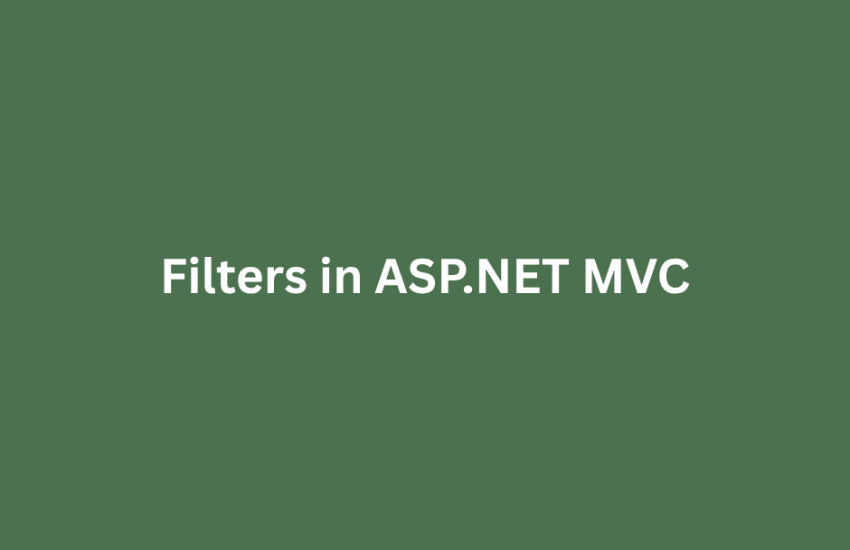ASP.NET MVC filters are a powerful mechanism that allows us to inject logic into the request-processing pipeline at various stages. They act as interceptors, enabling us to perform tasks such as authentication, authorization, logging, and error handling before or after an action method is executed.
Understanding the Pipeline:
Before diving into specific filter types, it’s crucial to understand the ASP.NET MVC request processing pipeline. When a request comes in, it goes through several stages:
- Routing: Determines which controller and action method should handle the request.
- Authorization: Checks if the user is authorized to access the requested resource.
- Action Execution: Executes the action method.
- Result Execution: Executes the result of the action method (e.g., rendering a view).
Filters can be applied at different points within this pipeline.
Types of Filters:
ASP.NET MVC provides several filter types, each with a specific purpose:
Authorization Filters (IAuthorizationFilter):
- Executed first in the pipeline.
- Used for authentication and authorization.
- Example: Checking if a user is logged in or has the necessary roles.
- OnAuthorization(AuthorizationContext filterContext) method is implemented.
Action Filters (IActionFilter):
- Executed before and after an action method is called.
- Used for tasks like logging, caching, and modifying action parameters or results.
- OnActionExecuting(ActionExecutingContext filterContext) and OnActionExecuted(ActionExecutedContext filterContext) methods are implemented.
Result Filters (IResultFilter):
- Executed before and after the result of an action method is executed.
- Used for tasks like modifying the response, adding headers, or formatting the output.
- OnResultExecuting(ResultExecutingContext filterContext) and OnResultExecuted(ResultExecutedContext filterContext) methods are implemented.
Exception Filters (IExceptionFilter):
- Executed when an unhandled exception occurs during the execution of the request.
- Used for error handling, logging exceptions, and providing custom error pages.
- OnException(ExceptionContext filterContext) method is implemented.
How to Implement Filters:
We can create custom filters by implementing the corresponding interface. Here’s a basic example of an action filter for logging:
public class LoggingFilter : ActionFilterAttribute
{
public override void OnActionExecuting(ActionExecutingContext filterContext)
{
// Log the start of the action execution
string controllerName = filterContext.ActionDescriptor.ControllerDescriptor.ControllerName;
string actionName = filterContext.ActionDescriptor.ActionName;
string logMessage = $"Action {controllerName}.{actionName} started.";
System.Diagnostics.Debug.WriteLine(logMessage);
base.OnActionExecuting(filterContext);
}
public override void OnActionExecuted(ActionExecutedContext filterContext)
{
// Log the end of the action execution
string controllerName = filterContext.ActionDescriptor.ControllerDescriptor.ControllerName;
string actionName = filterContext.ActionDescriptor.ActionName;
string logMessage = $"Action {controllerName}.{actionName} finished.";
System.Diagnostics.Debug.WriteLine(logMessage);
base.OnActionExecuted(filterContext);
}
}Applying Filters:
We can apply filters at different levels:
1. Global Filters: Applied to all actions in the application.
- Registered in Global.asax.cs
Example of global filter registration in Global.asax.cs:
public class MvcApplication : System.Web.HttpApplication
{
protected void Application_Start()
{
GlobalFilters.Filters.Add(new LoggingFilter());
}
}2. Controller Filters: Applied to all actions within a specific controller.
- Decorate the controller class with the filter attribute.
Example of a controller filter:
[LoggingFilter]
public class HomeController : Controller
{
// ... actions
}3. Action Filters: Applied to a specific action method.
- Decorate the action method with the filter attribute.
Example of an action filter:
public class HomeController : Controller
{
[LoggingFilter]
public ActionResult Index()
{
// ...
return View();
}
}Benefits of Using Filters:
- Code Reusability: Centralize common logic.
- Separation of Concerns: Keep cross-cutting concerns separate from action logic.
- Improved Maintainability: Easier to modify and update common logic.
- Enhanced Security: Implement authentication and authorization efficiently.
- Simplified Logging and Error Handling: Streamline these tasks.




